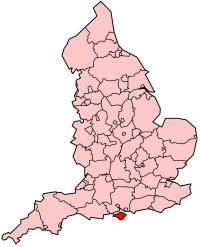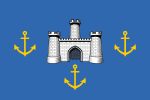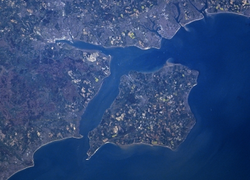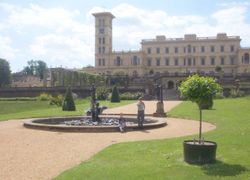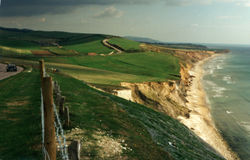Isle of Wight
2007 Schools Wikipedia Selection. Related subjects: Geography of Great Britain
The Isle of Wight is an English island and county, off the southern English coast, to the south of the county of Hampshire. It is part of the United Kingdom.
Popular from Victorian times as a holiday resort, the Isle of Wight is known for its natural beauty and as home to the Royal Yacht Squadron at Cowes, a town that hosts a world famous annual regatta. Colloquially, it is known as "The Island" by its residents. It possesses a rich history including its own brief status as a vassal kingdom in the fifteenth century, home to poet Alfred Lord Tennyson and Queen Victoria's much loved summer residence and final home Osborne House. Its maritime history encompasses boat building and sail making through to the manufacture of flying boats and the world's first hovercraft. It is home to the Isle of Wight Festival, which, in 1970, was one of the largest rock music events ever held, with estimates reaching 600,000 attendees, overtaking the record set at Woodstock a year earlier. The Isle of Wight Festival was revived in 2002 to critical acclaim, headliners in 2006 were Coldplay, Foo Fighters and The Prodigy. The island is also one of the richest fossil locations for dinosaurs in Europe.
In AD 686, it became the last part of the British Isles to convert to Christianity, almost a century after the rest of Great Britain.
The isle is the smallest ceremonial county in England (when not including Bristol or the City of London) at 380 km², just beating the revived Rutland at 382 km². With just one Member of Parliament and 132,731 permanent residents in the 2001 census, it is also the most populated Parliamentary constituency in the United Kingdom.
The Isle of Wight's county flower is the Pyramidal Orchid .
Geography and wildlife
Isle of Wight is approximately diamond in shape and covers an area of 147 square miles (381 square km). Slightly more than half of the island's, mainly in the west of the Island, is designated as the Isle of Wight Area of Outstanding Natural Beauty. The island has 99.6 square miles of farmland, 20 square miles of developed areas, and 57 miles of coastline. The landscape of the Island is remarkably diverse, leading to its oft-quoted description of "England in Miniature". The West Wight is predominantly rural, with dramatic coastlines dominated by the famous chalk downland ridge, running across the whole Island and ending in The Needles stacks - perhaps the most photographed aspect of the Isle of Wight. The highest point on the island is St Boniface Down, at 241m/791ft, which is also a Marilyn.
The rest of the Island landscape also has great diversity, with perhaps the most notable habitats being the soft cliffs and sea ledges, which are spectacular features as well as being very important for wildlife, and are internationally protected. The River Medina flows north into the Solent, whilst the other main river, the River Yar flows roughly north-east, emerging at Bembridge Harbour on the eastern end of the Island. Confusingly, there is another entirely separate river at the western end also called the River Yar flowing the short distance from Freshwater Bay to a relatively large estuary at Yarmouth. Where distinguishing the two becomes necessary, each may be referred to as the eastern or western Yar. The south coast of the island adjoins the English Channel.
Island wildlife is remarkable, thought to be the only place in England where the red squirrel is flourishing, with a stable population. Unlike the rest of England, no grey squirrels are to be found on the Island , nor are there any wild deer but, instead, rare and protected species, such as the dormouse and many rare bats, can be found. The Glanville Fritillary butterfly's distribution in the United Kingdom is largely restricted to the edges of the crumbling cliffs of the Isle of Wight.
History
Much of the land now making up the Isle of Wight was deposited during the late Cretaceous, at times part of a large river valley complex which consisted of much of the current southern coast of England. The swamps and ponds of the region at that time made the island excellent for the preservation of fossils, which means that it is now one of the richest locations for finding dinosaurs in Europe (for more information see the dinosaurs of the Isle of Wight article).
The Isle of Wight became an island sometime after the end of the last Ice Age. This was possibly because recovery from the last ice age has caused areas that were under the ice to rebound, but neighboring regions to subside. The Isle of Wight was located in an ice-free region, so in that area local relative sea level rose, flooding the Solent and separating the island from the mainland.
The island was part of the Celtic British Isles and, known to the Romans as Vectis, was captured by Vespasian in the Roman invasion. After the Roman era, the Isle of Wight was settled by the Jutes, a Germanic tribe, in the early stages of the Anglo-Saxon invasions. The latter's corruption of Vectis into Wiht (the Latin v was pronounced [w]) is the root of the island's name.
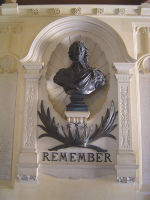
The Norman Conquest created the position of Lord of the Isle of Wight. Carisbrooke Priory and the fort of Carisbrooke Castle were founded. The island did not come under full control of the crown until it was sold by the dying last Norman Lord, Lady Isabella de Fortibus, to Edward I in 1293. The Lordship thereafter became a Royal appointment, with a brief interruption when Henry de Beauchamp, 1st Duke of Warwick was crowned King of the Isle of Wight, King Henry VI assisting in person at the ceremony, placing the crown on his head. He died in 1445, aged 22. With no male heir, his regal title expired with him.
Henry VIII, who developed the Royal Navy and its permanent base at Portsmouth, fortified the island at Yarmouth, East & West Cowes and Sandown, sometimes re-using stone from dissolved monasteries as building material. Sir Richard Worsley, Captain of the Island at this time, successfully commanded the resistance to the last of the French attacks in 1545. Much later on, after the Spanish Armada in 1588, the threat of Spanish attacks remained and the outer fortifications of Carisbrooke Castle were built, between 1597 and 1602. During the English Civil War King Charles fled to the Isle of Wight, believing he would receive sympathy from the governor Robert Hammond. Hammond was appalled, and incarcerated the king in Carisbrooke Castle.
Queen Victoria made Osborne House on the Isle of Wight her summer home for many years and, as a result, it became a major holiday resort for members of European royalty, whose many houses could later claim descent from her, through the widely flung marriages of her offspring. During her reign, in 1897, the World's first radio station was set up by Marconi, at the Needles battery, at the western tip of the Island.
In 1904, a mysterious illness began to kill honeybee colonies on the island and had nearly wiped out all hives by 1907, when the disease jumped to the mainland and decimated beekeeping in the British Isles. Called the Isle of Wight Disease, the cause of the mystery ailment was not identified until 1921, when it was traced to the mite Acarapis woodi. The disease (now called Acarine Disease) frightened many other nations, because of the importance of bees in pollination of many food plants. Laws against importation of honeybees were passed, but this merely delayed the eventual spread of the parasite to the rest of the world.
The Isle of Wight Festival could describe several events, but usually the term refers to one very large rock festival that took place near Afton Down, West Wight in 1970, following two smaller concerts in 1968 and 1969. The 1970 show was notable both for being one of the last public performances by Jimi Hendrix and for the number of attendees reaching, by many estimates, 600,000 (despite only 50,000 tickets being sold), and overtaking the attendance at Woodstock in the previous year. The festival was revived in 2002 and is now an annual event, with other, smaller musical events of many different genres across the Island becoming associated with it.
Politics
The Isle of Wight is a Ceremonial and Non-metropolitan county. It is effectively an English [[Unitary authority|Unitary] council]. It also has a single Member of Parliament, and is by far the most populous constituency in the UK (more than 50% above the average of English constituencies).
As a constituency of the House of Commons, it is traditionally a battleground between the Conservatives and the Liberal Democrats. The current MP, Andrew Turner is a Conservative, and his predecessor Dr Peter Brand was a Liberal Democrat.
The Isle of Wight Council election of 2005 was a landslide victory for the Conservative Party, displacing the long serving "Island First" group; a coalition of Liberal Democrats and independents.
Language and dialect
The distinctive Isle of Wight accent is a somewhat stronger version of the traditional Hampshire dialect, featuring the dropping of some consonants and an emphasis on longer vowels. This is similar to the West Country drawl heard in south-western England, but less removed in sound from the Estuary English of the South East. In common with many other English regional dialects and accents, a strong island accent is not now commonly heard, and as speakers tend to be older, this decline is likely to continue.
The island also has its own local and regional words. Some words, including grockle (visitor) and nipper/nips (a younger person) are still commonly used and are shared with neighbouring areas. A few are unique to the island, for example overner (a mainlander who has settled on the island) and caulkhead (someone born on the island or, for sticklers, those born there from long-established island stock). Other words are more obscure and used now mainly for comic emphasis, such as mallishag (meaning caterpillar) and nammit ("noon-meat", meaning food). Some other words are "Gurt" as in large, also "Gallybagger" as in scarecrow.
Economy
This is a chart of trend of regional gross value added of Isle of Wight at current basic prices published (pp.240-253) by Office for National Statistics with figures in millions of British Pounds Sterling.
| Year | Regional Gross Value Added | Agriculture | Industry | Services |
|---|---|---|---|---|
| 1995 | 831 | 28 | 218 | 585 |
| 2000 | 1,202 | 27 | 375 | 800 |
| 2003 | 1,491 | 42 | 288 | 1,161 |
Industry and agriculture
The largest industry on the Isle of Wight is tourism, but the Island has a strong agricultural heritage, including sheep, dairy farming and arable crops. Traditional agricultural commodities are more difficult to market off the Island because of transport costs, but Island farmers have managed successfully to exploit some specialist markets. The high price of these products overcomes the transport costs. One of the most successful agricultural sectors at present is crops grown undercover, particularly salad crops, including tomatoes and cucumbers. The Isle of Wight has a longer growing season than much of the United Kingdom and this also favours such crops. Garlic has been successfully grown in Newchurch for many years, and is even exported to France. This has led to the establishment of an annual Garlic Festival at Newchurch, which is one of the largest events of the Island's annual calendar. The favourable climate has led to the success of vineyards, including one of the oldest in the British Isles, at Adgestone near Sandown . Lavender is also grown for its oil .
The making of sailcloth, boats and other connected maritime industry has long been associated with the island, although somewhat diminished in recent years. Although they have reduced the extent of the plants and workforce, including the sale of the main site, GKN operate what was once the British Hovercraft Corporation a subsidiary of, and latterly when manufacturing focus changed known as, Westland Aircraft. Prior to its purchase by Westland, it was the independent Saunders-Roe. It remains one of the most notable historical firms, having produced many of the flying boats, and the world's first hovercraft. The island's major manufacturing activity today is in composite materials, including a large manufacturer of wind turbine blades (Vesta's).
Bembridge airfield on the island is the home of Britten-Norman, manufacturers of the world-famous Islander and Trislander aircraft. This is shortly to become the site of the European assembly line for Cirrus light aircraft. The Norman Aeroplane Company is a smaller aircraft manufacturing company operating in Sandown. There are have been 3 other aircraft manufacturers that built planes on the island.
A major contribution to the local economy comes from the world-famous international sailing regatta, Cowes Week, which is held every August and attracts over a hundred thousand visitors to the island. Other major sailing events are held at Cowes, including the Admiral's Cup held biennially in July and the Commodores' Cup in August.
In 2005, Northern Petroleum began exploratory drilling for oil, with its Sandhills-2 borehole at Porchfield but ceased operations in October that year, after failing to find significant reserves.
Services
Tourism and heritage
The heritage of the Island is a major asset, which has for many years kept its economy going. Holidays focused on natural heritage, including both wildlife and geology, are becoming a growing alternative to the traditional seaside resort holiday. The latter has been in decline in the UK domestic market, due to the increased affordability of air travel to alternative destinations.
Tourism is still the largest industry on the Island. In 1999, the 130,000 island residents were host to 2.7 million visitors. Of these, 1.5 million stayed overnight, and 1.2 million visits were day visits. Only 150 thousand of these visitors were international visitors. Between 1993 and 2000, visits increased at a rate of 3% per year, on average.
As well as more traditional tourist attractions, the island is often host to walking or cycling holidays, through the attractive scenery. Almost every town and village on the Island plays host to hotels, hostels and camping sites. Out of the peak summer season, the island is still an important destination for coach tours from other parts of the United Kingdom and an annual walking festival has attracted considerable interest.
Transport and communications
By far the main form of access is by boat from the mainland, with regular vehicle ferry services and passenger services being available through the ferry companies:
- Red Funnel - operates a car and passenger service between Southampton and East Cowes. High speed passenger-only services to Southampton operate from "West" Cowes under the name of "Red Jet".
- Wightlink - operates a car and passenger service between Portsmouth and Fishbourne (near Ryde), and between Lymington and Yarmouth. It also operates a passenger-only service between Portsmouth Harbour (train station) and Ryde Pier Head (train station) under the name "Fast Cat" (known as the Vomit Comet by the locals due to its colour), so named because the boats used are catamarans.
- Hovertravel - carries passengers between Southsea and Ryde aboard a hovercraft.
There are regular proposals for further routes, and during Cowes Week additional services have been known to operate - notably a fast catamaran service between West Cowes and Lymington.
The island is the home of the smallest train operating company in the United Kingdom's National Rail network, the Island Line. This runs some 8½ miles from Ryde Pier Head to Shanklin, down the eastern side of the island via Brading and Sandown. These are electric trains, using former London Underground trains.
The island also has a steam-operated heritage railway, the Isle of Wight Steam Railway. The steam railway connects with the Island Line at Smallbrook Junction.
A sign used to greet visitors to the Island disembarking from the car ferry at Fishbourne, stating 'Island roads are different, please drive carefully'. It is a joke amongst local residents that the reason Island roads are different is due to a lack of maintenance by the council. Nevertheless the lighter traffic, quieter roads and slower speeds are noticeable to the visitor and are one of the reasons the Island has remained attractive to tourists from the busier mainland. The island has 489 miles of roadway.
There are two small airfields for General Aviation: Isle of Wight Airport at Sandown and Bembridge Airport . These are busy with day-trippers in summer, travelling by light aircraft.
All of the Island telephone exchanges are broadband enabled and in addition, some urban areas such as Cowes and Newport are covered by cable lines. Some areas, such as Arreton, have no broadband in certain places.
The Isle of Wight County Press is the major local newspaper, published weekly each Friday or the last working day before a public holiday falls on that day. There is also a local radio station, Isle of Wight Radio , broadcasting on 107 and 102 FM (also available over the internet), and a regional television station which broadcasts from the Island, Solent TV .
Prisons
The island geography close to the densely populated south of England led to it gaining three prisons: Albany, Camphill and Parkhurst located outside Newport on the main road to Cowes. Albany and Parkhurst were once among the few Category A prisons in the UK until they were downgraded in the 1990s. The downgrading of Parkhurst was precipitated by a major escape: three prisoners (known to be some of the most dangerous murderers in the prison system) made their way out of the prison on 3 January 1995 to enjoy four days of freedom before being recaptured. Parkhurst especially enjoyed notoriety as one of toughest jails in the British Isles and "hosted" many notable inmates, including the Yorkshire Ripper Peter Sutcliffe and the Kray twins.
Camphill is located 1 mile (1.6Km) to the west of Albany and Parkhurst, on the very edge of Parkhurst Forest. Originally an army barracks with a small estate of tree-lined roads with well-proportioned officer's houses (with varying grandeur according to rank) to the South and East. Having been converted to a borstal and later a low category prison, it maintains its ties to the housing around it as although now most privately owned, clean water is still provided from the prison itself and residents pay only sewerage fees to the water authority (Southern Water). The estate is accessed by two, gated, private roads. These are closed for one day each year so as not to become a public right of way.
Education
Settlements
Selected places of interest
| Key | |
| |
National Trust |
| |
English Heritage |
| |
Forestry Commission |
| Country Park | |
| Accessible open space | |
| Museums (free/not free) | |
| Heritage railway | |
| Historic House | |
- Alum Bay
- Appuldurcombe House

- Blackgang Chine
- Carisbrooke Castle

- Dinosaur Isle

- Golden Hill Fort

- Fort Victoria

- Isle of Wight Steam Railway

- Osborne House

- The Needles

- Robin Hill
- Yarmouth Castle

- Quarr Abbey
